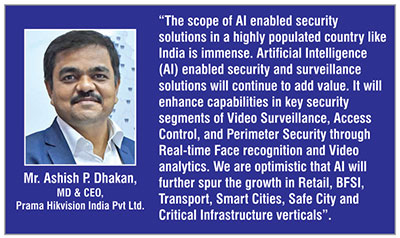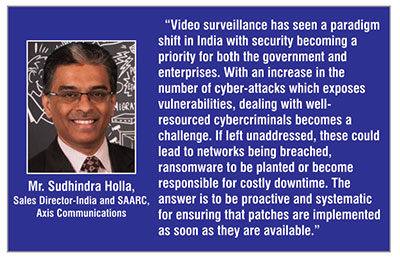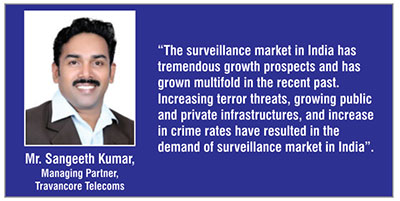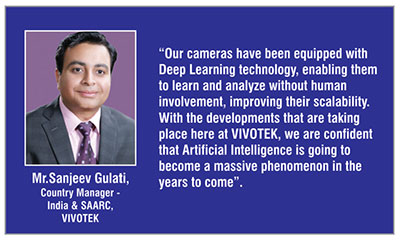 Traditionally, dominated by analogue systems, the video surveillance market in India is set to take the next leap with IP surveillance cameras gradually penetrating the market, which in turn, is driving the demand for video analytics software.
Traditionally, dominated by analogue systems, the video surveillance market in India is set to take the next leap with IP surveillance cameras gradually penetrating the market, which in turn, is driving the demand for video analytics software.
Witnessing leaps and bounds in technological progress brings forth optimism and a sense of security about the future. Having witnessed the profound effects that wireless communications, the Internet, enterprise applications and various other technologies have recently had on different industry verticals, technology will be the source of continued disruption to markets and industries in the coming decade.
 One such industry that is going to witness a tremendous upsurge in innovative new technology is the Video Surveillance Industry. Cities have now installed thousands of surveillance cameras within their limits, and retailers have installed hundreds of cameras in their stores and this trend will only continue to grow.
One such industry that is going to witness a tremendous upsurge in innovative new technology is the Video Surveillance Industry. Cities have now installed thousands of surveillance cameras within their limits, and retailers have installed hundreds of cameras in their stores and this trend will only continue to grow.
Surveillance devices
To begin with, there are mainly two types of surveillance devices, analog-based cameras and IP-driven surveillance cameras. As it can be inferred by their names, analog-based cameras transmit the video feed by leveraging the analog signals that can be received by television or other receivers such as monitors, VCRs, and so on. On the other hand, IP surveillance devices, also called the network cameras, digitize the video signals using dedicated encoders – making them accessible through the existing network or via the internet.
 As one of their merits, IP surveillance devices enable us to process the video feed using video analytics and derive useful insights from them. Its other benefits include remote accessibility, integration of wide-ranging technologies (video dewarping, Wide Dynamic Range, motion detection, and other Artificial Intelligence-driven functionality, etc.), leaner infrastructure, and the ability to automate manual processes alongside others.
As one of their merits, IP surveillance devices enable us to process the video feed using video analytics and derive useful insights from them. Its other benefits include remote accessibility, integration of wide-ranging technologies (video dewarping, Wide Dynamic Range, motion detection, and other Artificial Intelligence-driven functionality, etc.), leaner infrastructure, and the ability to automate manual processes alongside others.
Today, these IP surveillance devices are being used for a number of use cases including traffic management, performance analysis, deriving business intelligence, and triggering alert for a given use case. The advents of these IP surveillance devices have been pivotal in driving the demand for surveillance devices on a global scale. And the same stand to be true for the Indian market. So, we should have a look at how the surveillance market is panning out in India.
India’s surveillance sector Future
As digitization continues to gain currency in our country, with more people adopting the digital technology for its innumerable advantages, Indian businesses of all shapes and sizes have also been eyeing digital solutions to drive greater productivity and effectiveness for wide-ranging applications. It is enabling them to do with human resource unavailability, the errors and omissions inherent to it due to fatigue and negligence, and the limitations of earlier network.
 At present, the security and surveillance industry is steadily growth with a CAGR of 32% and this growth rate is expected to be sustained at least till 2023. The current market size, including IP and analog solutions, is around Rs. 20 billion.
At present, the security and surveillance industry is steadily growth with a CAGR of 32% and this growth rate is expected to be sustained at least till 2023. The current market size, including IP and analog solutions, is around Rs. 20 billion.
India is a price-sensitive market but as more businesses realize the need of a specialized and seamless surveillance and security solution, the demand for an all-encompassing and integrated alternative can be seen brewing within the market. Also, though IP surveillance cameras are being readily adopted, the market is aware that these solutions are based on the IoT (Internet of Things) technology, which is relatively novel and has more than 70,000 known CVEs (Common Vulnerabilities and Exposures) vis-à-vis cybersecurity.
 So, as IP surveillance cameras continue to gain traction, the need to secure this network layer, which has increased the overall network boundary of organizations, is also imperative. The industry has to holistically move towards this direction as a forward-looking approach and address the cybersecurity concerns to ensure that any undesirable event doesn’t occur in the future.
So, as IP surveillance cameras continue to gain traction, the need to secure this network layer, which has increased the overall network boundary of organizations, is also imperative. The industry has to holistically move towards this direction as a forward-looking approach and address the cybersecurity concerns to ensure that any undesirable event doesn’t occur in the future.
To sum up, the future seems to be bright for the security and surveillance industry in India. Everything is pointing towards the deployment of a proactive infrastructure that is soon going to help our nation to do away with its current challenges and ultimately making it more productive, efficient, and effective.
Predictions for the Surveillance industry 2019
Artificial Intelligence
For all the attention and discussion, you could be forgiven for thinking that artificial intelligence (AI) is fundamentally changing every industry and sector. Though for the more cynical (and with reference to the Gartner Hype Cycle) you may feel that a lack of demonstrable applications of AI (and the associated machine learning and deep learning) points to either a Peak of inflated expectations or even the Trough of disillusionment. In reality, of course, progress differs from industry to industry and from application to application. In some fields – notably healthcare and specifically cancer detection – AI is already having a significant positive impact. In other areas, progress is steadier. Video surveillance is one of them.
In our industry today, machine or deep-learning is mostly used for video analytics, but we expect the technology will be an important component in many different applications and products in the future. Over time it will become a common tool for software engineers and will be included in many different environments and devices. But, again, its application will be driven by the most compelling use cases, not by the technology itself. There is a temptation in the surveillance and security sector to over-promise in relation to new technologies. This has been true of AI in video analytics and, particularly, in some of the claims made around the current application of deep learning. With AI and deep learning, as with any new technology, we’re committed to making sure its implementation is robust, reliable and addresses real customer challenges.
Cloud and edge computing
If AI could still be said to be in the earlier stages of the Gartner Hype Cycle, it’s difficult to argue that cloud computing is anything other than firmly established and heading towards, if not already on, the Plateau of productivity. There can be few organizations in the private or public spheres that aren’t making use of cloud computing at some level, and many have moved their entire infrastructures to a cloud-based model.
That said, cloud computing is based on the centralized computing in one or many data center, and as the proliferation of connected, Internet of Things (IoT) devices grows exponentially, so does the amount of data produced. Even as more data centers with ever-increased capacity are created, this tsunami of data could become overwhelming. This can be particularly critical in areas such as video surveillance, where despite the development of technologies designed to reduce storage and bandwidth needs, data demands are still significant.
Personalization vs privacy
The year to be considered as the year when broad awareness of data privacy reached its highest point particularly that associated with personal information. To those in the public and private sectors, the EU’s General Data Protection Regulation (GDPR) bought a higher level of scrutiny than ever before to how organizations collect, store, share and use personal information (including that captured by video surveillance). To the broader consumer, however, it is more likely to be issues relating to Facebook’s use of data which has heightened awareness and concern regarding what happens to the personal data given away online.
Ultimately, we live in a world where we have been given valuable online services in exchange for knowingly or unconsciously handing over a significant amount of personal data. Indeed, this data is used by the likes of Facebook, Amazon, Google and others to increase the value of these services through a high degree of personalization. To many, however, it feels like a line has been crossed between useful personalization and invasion of privacy, and the rumors that home voice assistants listen in to domestic conversations will only cause this unease to increase.
Ultimately, the trust between an organization and its customers is becoming an increasingly important and tangible asset. Indeed, recent research from consulting firm Accenture has established a correlation between stakeholder trust and revenue. Concerns about a company’s approach to privacy and the use of personal data will be one of the most impactful aspects of trust in business moving forwards.
Cybersecurity
Can something continue to be a ‘trend’ when it appears every year, and is a constant concern? Whatever your answer to that question, it’s impossible to think about issues that will affect every sector this year without a mention of cybersecurity. Indeed, in relation to the previous point, the fastest way to damage trust between a company and its customers (and shareholders) is through a cybersecurity breach. Just ask British Airways.
Cybersecurity will never be solved, because the cybercriminals (and increasingly nation states) will never stop trying to find and exploit vulnerabilities. These organizations are incredibly well-funded and organized and can innovate much more quickly than companies that need to adhere to industry regulations. Attacks are becoming more sophisticated, at a time when the number of connected devices mean that potential vulnerabilities and insecure network end-points are growing exponentially.
One particular area of vulnerability that has been highlighted recently is in the supply chain, where either a lack of good cybersecurity practice or even deliberately malicious actions can result in cybersecurity breaches being achieved through both software and hardware. The provenance of products is ever more critical than ever, with manufacturers needing to be confident that every link in their supply chain is a secure as it should be.
Smart technology to deliver environmental benefits
We’ve already seen how video analytics can be used as an operational planning tool by organizations looking to improve energy efficiency within offices, with the subsequent positive benefits for the environment. But new types of sensors can more accurately measure environmental impact across an organization’s sites, effectively acting as highly sensitive artificial ‘noses’ calibrated to different forms of output, and thermal imaging can be used to pinpoint areas of energy wastage.
For instance, one critical area where such sensors can heighten awareness, understanding and, increasingly allow for remedial action is in air quality. Whether inside buildings or in the external urban environment, the negative impacts on health and associated costs are becoming an ever-greater issue. Smart sensors will have a central role to play in addressing the problem globally.
Sensor integration driving smart actions
In themselves, individual sensors such as those described above can deliver significant benefits. But a final trend that we’re confident will be increasingly prevalent in 2019 will be combining and integrating sensors to prompt ‘smart’ actions.
Technology continues to develop at a rapid and accelerating pace. While it can be easy to become distracted by the potential of every new trend or innovation, each must be considered in relation to the use cases that are going to deliver maximum positive impact and value to organizations and citizens. This remains the lens through which we view technology trends and their application, and 2019 promises to be another exciting year in bringing new technologies to market in increasingly useful ways.






